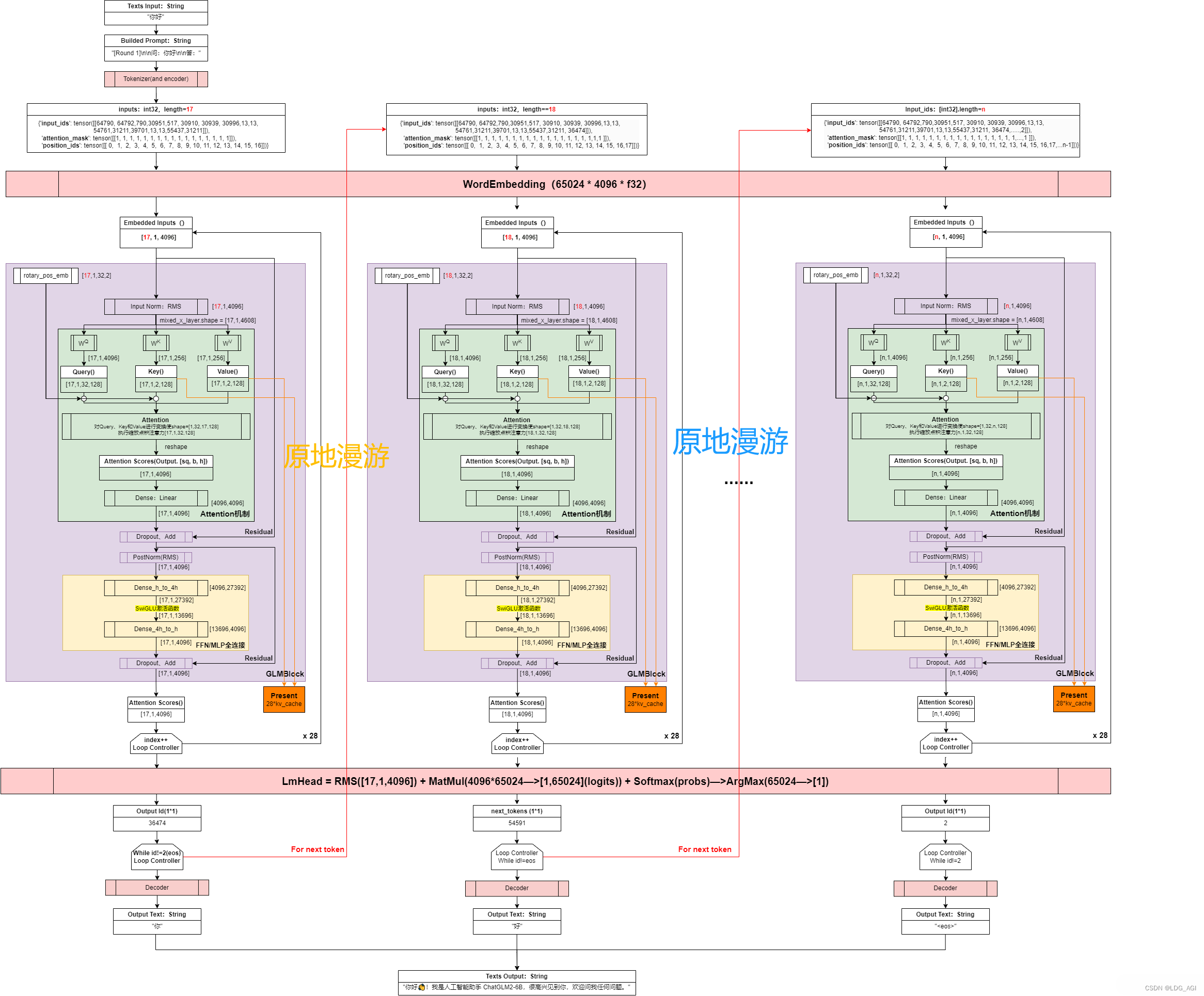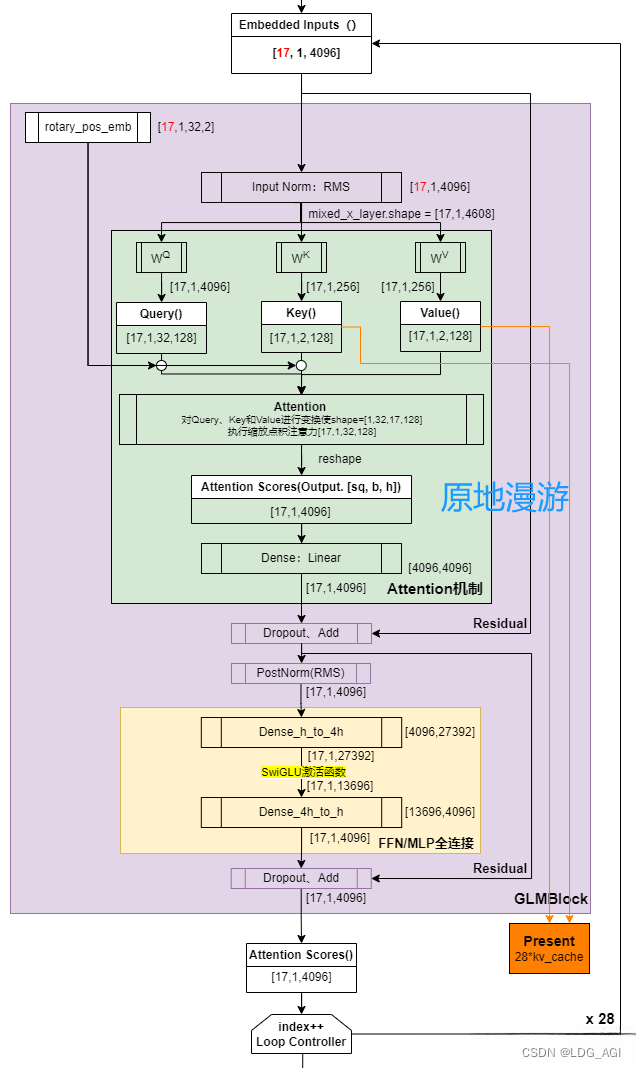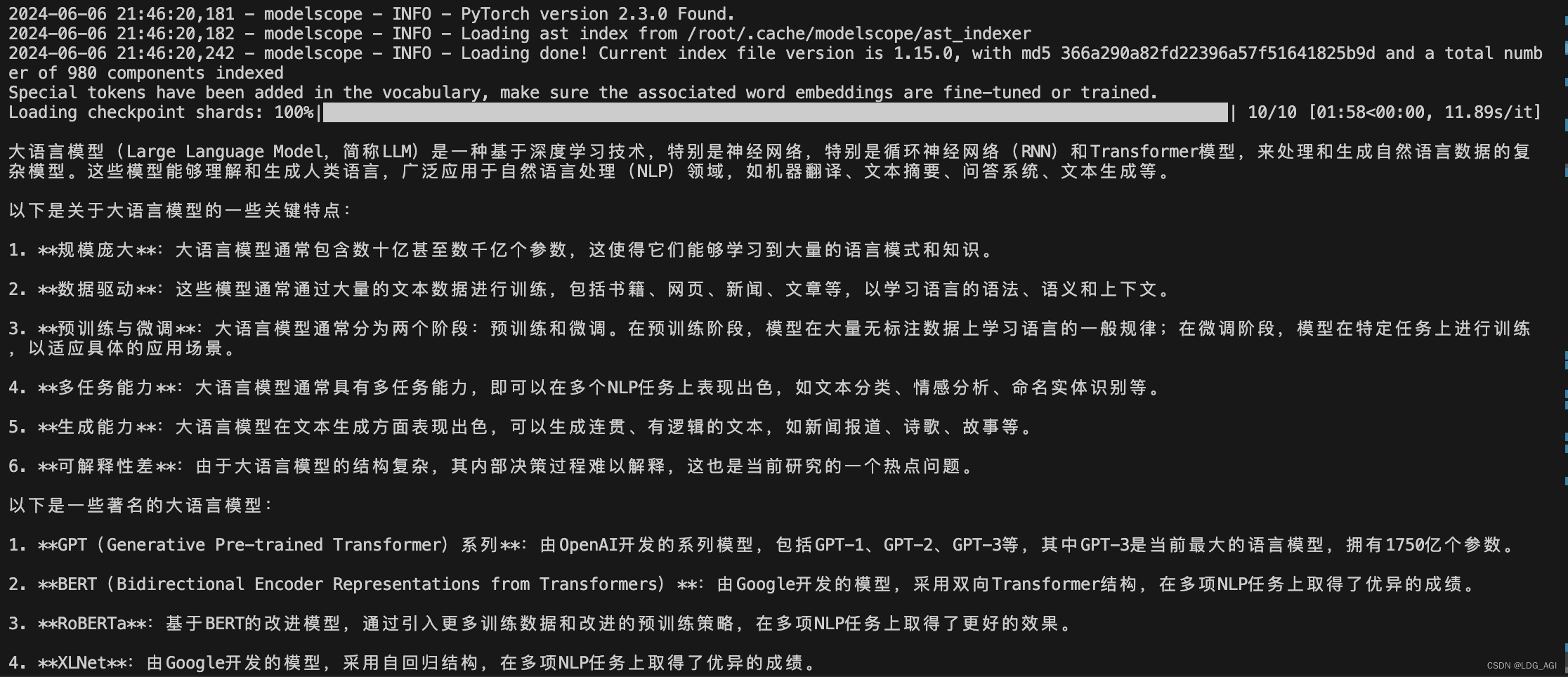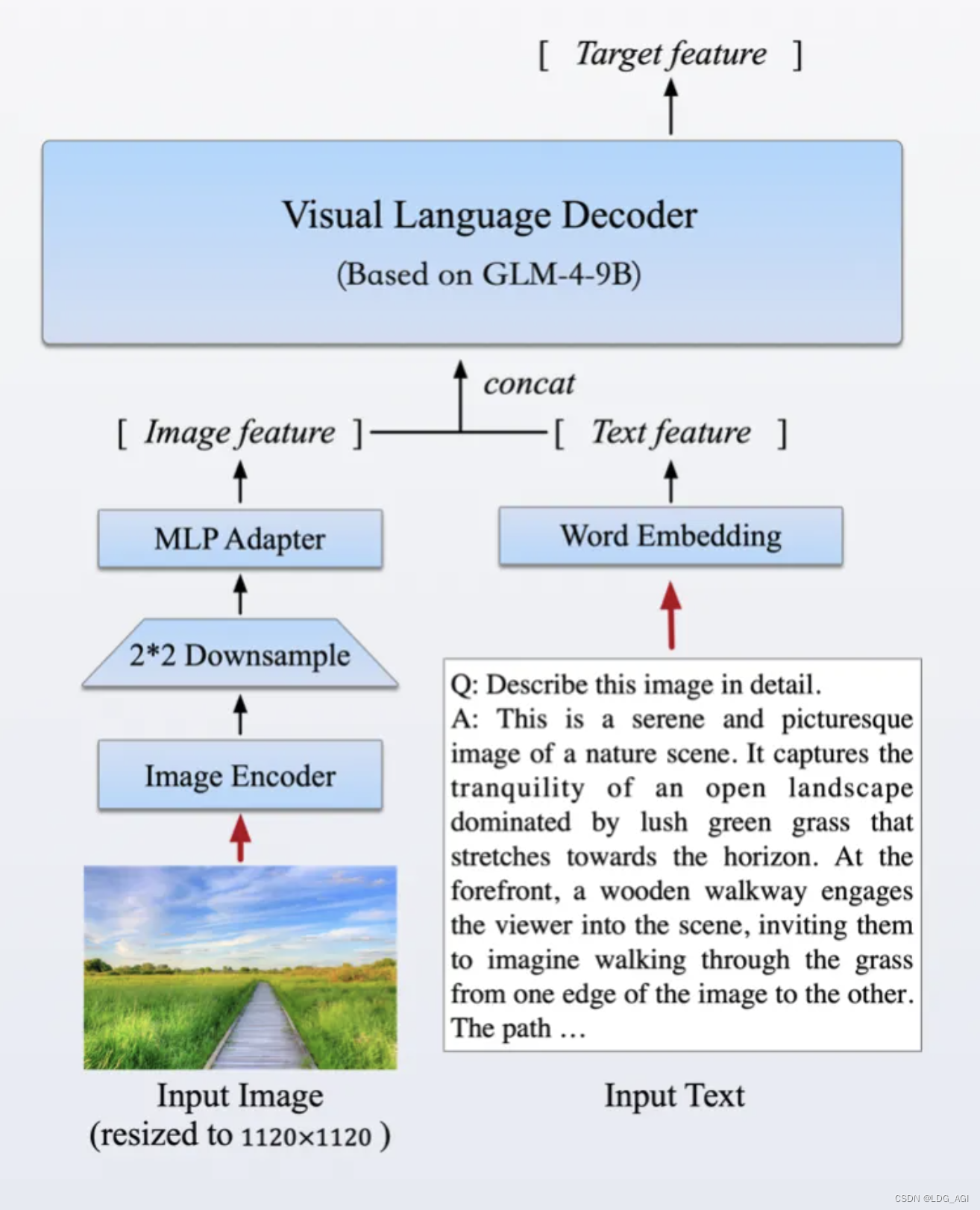【机器学习】GLM4-9B-Chat大模型/GLM-4V-9B多模态大模型概述、原理及推理实战
目录
一、引言
二、模型简介
2.1 GLM4-9B 模型概述
2.2 GLM4-9B 模型架构
三、模型推理
3.1 GLM4-9B-Chat 语言模型
3.1.1 model.generate
3.1.2 model.chat
3.2 GLM-4V-9B 多模态模型
3.2.1 多模态模型概述
3.2.2 多模态模型实践
四、总结
一、引言
周一(6.3)写完【机器学习】Qwen1.5-14B-Chat大模型训练与推理实战 ,周二(6.4)首次拿下CSDN热榜第一名,周三(6.5)清华智谱宣布开源GLM-4-9B,今天周四(6.6)马不停蹄开始部署实验+码字。
自ZHIPU AI于2023年3月14日发布ChatGLM-6B,截止目前,该系列已经发布了4代:ChatGLM-6B、ChatGLM2-6B、ChatGLM3-6B以及最新发布的GLM-4-9B。
二、模型简介
2.1 GLM4-9B 模型概述
GLM4-9B相较于上一代ChatGLM3-6B,主要有以下几点变更:
- 预训练数据量提升3倍:在预训练方面,引入了大语言模型进入数据筛选流程,最终获得了 10T 高质量多语言数据。
- 训练效率提高了 3.5 倍:采用了 FP8 技术进行高效的预训练,相较于第三代模型,训练效率提高了 3.5 倍。
- 模型规模提升至 9B:在有限显存的情况下,探索了性能的极限,并发现 6B 模型性能有限。因此,在考虑到大多数用户的显存大小后,将模型规模提升至 9B,并将预训练计算量增加了 5 倍。
综合以上技术升级和其他经验,GLM-4-9B 模型具备了更强大的推理性能、更长的上下文处理能力、多语言、多模态和 All Tools 等突出能力。GLM-4-9B 系列模型包括:
- 基础版本 GLM-4-9B(8K):基础版本。
- 对话版本 GLM-4-9B-Chat(128K):人类偏好对齐的版本。除了能进行多轮对话,还具备网页浏览、代码执行、自定义工具调用(Function Call)和长文本推理(支持最大 128K 上下文)等高级功能。
- 超长上下文版本 GLM-4-9B-Chat-1M(1M):支持 1M 上下文长度(约 200 万中文字符)。
- 多模态版本 GLM-4V-9B-Chat(8K): 具备 1120 * 1120 高分辨率下的中英双语多轮对话能力。
官方能力缩影图如下:
2.2 GLM4-9B 模型架构
GLM模型从发布之初,最主要的特点是将encoder-decoder相结合:
- 自编码:随机 MASK 输入中连续跨度的 token
- 自回归:基于自回归空白填充的方法重新构建跨度中的内容
具体模型,这里看一下“原地漫游”大佬在ChatGLM2-6B模型推理流程和模型架构详解 中做的GLM架构图:
架构中包含输入层、Embedding层、GLMBlock*28层、RMS层、输出层,以及Residual网络和Rope。其中最核心的在于GLMBlock*28(GLM4-9B-Chat已经升级为GLMBlock*40)
- 输入层:
- Tokenizer:将输入的文本序列转换为字或词标记的序列
- Input_ids:将Tokenizer生成的词标记ID化。
- Embedding层:
- 将每个ID映射到一个固定维度的向量,生成一个向量序列作为模型的初始输入表示
- GLMBlock*28:重复28次(GLM4-9B-Chat升级为40次),类似qwen1.5中将layer堆叠,包含2个大部分
- Self-Attention:先将输入进行Q、K、V矩阵映射,引入RoPE位置网络后,再进行attention注意力计算,最后线性变换为输入同样的维度。输出后引入残差网络、Dropout、RMSNorm等方法方式过拟合。
- Feed-Forward Network (MLP):经过两层全连接变换,最多扩至13696维度(GLM4,ChatGLM3均为13696,ChatGLM2是27392),提升表征能力。激活函数使用Swiglu代替Relu。与self-attention的输出后一样,同样引入Dropout、RMSNorm方法。
- RMSNorm层:标准化,这里使用RMSNorm(均方根标准化)代替LayerNorm(层标准化),具有加速训练和改善模型的泛化能力的效果,在实际的推荐系统工作中经常用到BatchNorm(批量标准化),在神经元激活函数前,加上一个BN层,使得每个批次的神经元输出遵循标准正态分布,解决深度传播过程中随数据分布产生的协变量偏移问题。
- 输出层:将将embedding转换会字词编码,之后decode为我们看到的文字。
- Residual Connection:残差连接网络,在深度学习中经常用到的技巧,在神经网络的层与层之间添加一个直接的连接,允许输入信号无损地传递到较深的层。这样设计的目的是为了缓解梯度消失和梯度爆炸问题,同时促进梯度在深层网络中的流畅传播,使得训练更高效,模型更容易学习复杂的特征
- Rotary Position Embedding(RoPE):旋转位置编码,Qwen、LLaMA也在用,可以更好的学习词之间的位置信息。
附GLMBlock官方源码:
class GLMBlock(torch.nn.Module): """A single transformer layer. Transformer layer takes input with size [s, b, h] and returns an output of the same size. """ def __init__(self, config: ChatGLMConfig, layer_number, device=None): super(GLMBlock, self).__init__() self.layer_number = layer_number self.apply_residual_connection_post_layernorm = config.apply_residual_connection_post_layernorm self.fp32_residual_connection = config.fp32_residual_connection LayerNormFunc = RMSNorm if config.rmsnorm else LayerNorm # Layernorm on the input data. self.input_layernorm = LayerNormFunc(config.hidden_size, eps=config.layernorm_epsilon, device=device, dtype=config.torch_dtype) # Self attention. self.self_attention = SelfAttention(config, layer_number, device=device) self.hidden_dropout = config.hidden_dropout # Layernorm on the attention output self.post_attention_layernorm = LayerNormFunc(config.hidden_size, eps=config.layernorm_epsilon, device=device, dtype=config.torch_dtype) # MLP self.mlp = MLP(config, device=device) def forward( self, hidden_states, attention_mask, rotary_pos_emb, kv_cache=None, use_cache=True, ): # hidden_states: [s, b, h] # Layer norm at the beginning of the transformer layer. layernorm_output = self.input_layernorm(hidden_states) # Self attention. attention_output, kv_cache = self.self_attention( layernorm_output, attention_mask, rotary_pos_emb, kv_cache=kv_cache, use_cache=use_cache ) # Residual connection. if self.apply_residual_connection_post_layernorm: residual = layernorm_output else: residual = hidden_states layernorm_input = torch.nn.functional.dropout(attention_output, p=self.hidden_dropout, training=self.training) layernorm_input = residual + layernorm_input # Layer norm post the self attention. layernorm_output = self.post_attention_layernorm(layernorm_input) # MLP. mlp_output = self.mlp(layernorm_output) # Second residual connection. if self.apply_residual_connection_post_layernorm: residual = layernorm_output else: residual = layernorm_input output = torch.nn.functional.dropout(mlp_output, p=self.hidden_dropout, training=self.training) output = residual + output return output, kv_cache附GLMBlock大图(by 原地漫游):
三、模型推理
3.1 GLM4-9B-Chat 语言模型
以为官方样例代码直接就能跑,结果由于网络、GPU、依赖包版本问题卡了好久(有趣的是,GLM卡了太长时间,于是先去Qwen1.5官网找了源码,调通后平移到GLM。这怎么评价呢):
- 网络:使用modelscope代替huggingface下载模型
- GPU:transformers支持多种GPU指定方式,这里用到了两种,均以字符串"cuda:2"形式指定
- tokenizer或model变量后加.to("cuda:2")方法
- 在from_pretrained里加入device_map="cuda:2"参数。
- pip安装依赖包:transformers、mdeolscope、torch==2.3.0、torchvision==0.18.0,最好用腾讯源安装,节约很多时间
pip install torch==2.3.0 -i https://mirrors.cloud.tencent.com/pypi/simple
3.1.1 model.generate
需要apply_chat_template(应用对话模版)引入对话messages数组以及设置add_generation_prompt=True对含有对话角色的message输入进行解析处理。大致意思就是将多个对话安装顺序展开成一行,并在每个角色对话之间加入“特殊符号”分割区分。具体可以参考如何设置transformers的聊天模板chat_template?
from modelscope import snapshot_download from transformers import AutoTokenizer, AutoModelForCausalLM model_dir = snapshot_download('ZhipuAI/glm-4-9b-chat') import torch device = "cuda:2" # the device to load the model onto tokenizer = AutoTokenizer.from_pretrained(model_dir,trust_remote_code=True) prompt = "介绍一下大语言模型" messages = [ {"role": "system", "content": "你是一个智能助理."}, {"role": "user", "content": prompt} ] text = tokenizer.apply_chat_template( messages, tokenize=False, add_generation_prompt=True ) model_inputs = tokenizer([text], return_tensors="pt").to(device) model = AutoModelForCausalLM.from_pretrained( model_dir, device_map="cuda:2", trust_remote_code=True ) gen_kwargs = {"max_length": 512, "do_sample": True, "top_k": 1} with torch.no_grad(): outputs = model.generate(**model_inputs, **gen_kwargs) outputs = outputs[:, model_inputs['input_ids'].shape[1]:] print(tokenizer.decode(outputs[0], skip_special_tokens=True)) """ generated_ids = model.generate( model_inputs.input_ids, max_new_tokens=512 ) generated_ids = [ output_ids[len(input_ids):] for input_ids, output_ids in zip(model_inputs.input_ids, generated_ids) ] response = tokenizer.batch_decode(generated_ids, skip_special_tokens=True)[0] print(response) """运行结果如下:
共计消耗GPU显存18G
3.1.2 model.chat
代码干净简洁好理解,并可以轻松实现多轮对话。只需要实例化tokenizer和model就可以了。ChatGLM和Qwen1.0早期均采用model.chat直接生成对话作为样例,后来可能系统提示词system prompt太刚需了,所以都采用apply_chat_template了。是这样吗?
from modelscope import snapshot_download from transformers import AutoTokenizer, AutoModelForCausalLM model_dir = snapshot_download('ZhipuAI/glm-4-9b-chat') #from modelscope import AutoModelForCausalLM, AutoTokenizer #from modelscope import GenerationConfig tokenizer = AutoTokenizer.from_pretrained(model_dir, trust_remote_code=True) model = AutoModelForCausalLM.from_pretrained(model_dir, device_map="cuda:2", trust_remote_code=True, torch_dtype=torch.bfloat16).eval() #model.generation_config = GenerationConfig.from_pretrained("ZhipuAI/glm-4-9b-chat", trust_remote_code=True) # 可指定不同的生成长度、top_p等相关超参 response, history = model.chat(tokenizer, "你好", history=None) print(response) response, history = model.chat(tokenizer, "浙江的省会在哪里?", history=history) print(response) response, history = model.chat(tokenizer, "它有什么好玩的景点", history=history) print(response)多轮对话结果:
3.2 GLM-4V-9B 多模态模型
同时,GLM还发布了图像识别大模型GLM-4V-9B(8K):
3.2.1 多模态模型概述
该模型采用了与CogVLM2相似的架构设计,能够处理高达1120 x 1120分辨率的输入,并通过降采样技术有效减少了token的开销。为了减小部署与计算开销,GLM-4V-9B没有引入额外的视觉专家模块,采用了直接混合文本和图片数据的方式进行训练,在保持文本性能的同时提升多模态能力。
3.2.2 多模态模型实践
上自己调通的代码(官方代码一直提示识别不到内容,无奈只能基于qwen-vl代码改,qwen-vl与glm-4v的chat函数还不一样,追着源码调了半天):
识别样例图片:
识别代码:
from modelscope import snapshot_download from transformers import AutoTokenizer, AutoModelForCausalLM model_dir = snapshot_download('ZhipuAI/glm-4v-9b') #model_dir = snapshot_download('qwen/Qwen-VL-Chat') #本来想一套代码支持qwen-vl和glm-4v,发现两个模型的chat函数传参不同,需要特殊处理适配 import torch from PIL import Image device = "auto" # the device to load the model onto tokenizer = AutoTokenizer.from_pretrained(model_dir,trust_remote_code=True) model = AutoModelForCausalLM.from_pretrained(model_dir, device_map=device, trust_remote_code=True,torch_dtype=torch.float16).eval() image = Image.open("./demo.jpeg").convert("RGB") response, history = model.chat(tokenizer,image=image, query="这是什么?", history=None) print(response) response, history = model.chat(tokenizer, query='再说一遍都有什么', history=history) print(response)这里AutoModelForCausalLM.from_pretrained()后面添加了.eval(),设置为评估模式(evaluation mode)。在评估模式下,模型的行为会有所不同,比如某些层(如Dropout)会关闭其随机性,这对于预测和评估阶段是必要的。
本来想一套代码支持qwen-vl和glm-4v,调试发现model.chat()传参数不同,需要判断适配,这里只放出了支持glm-4v的代码
占用显存(28.3G,官方表示glm-4v是13B,按照之前文章中总结的规律13*2.2=28.6G,差不多):
附qwen-vl代码:
from modelscope import snapshot_download from transformers import AutoTokenizer, AutoModelForCausalLM #model_dir = snapshot_download('ZhipuAI/glm-4v-9b') model_dir = snapshot_download('qwen/Qwen-VL-Chat') import torch from PIL import Image device = "auto" # the device to load the model onto tokenizer = AutoTokenizer.from_pretrained(model_dir,trust_remote_code=True) model = AutoModelForCausalLM.from_pretrained(model_dir, device_map=device, trust_remote_code=True,fp16=True).eval() query = tokenizer.from_list_format([ {'image': './test.png'}, # Either a local path or an url {'text': '这是什么?'}, ]) response, history = model.chat(tokenizer, query=query,history=None) print(response) response, history = model.chat(tokenizer, query='框出图中的小狗', history=history) print(response) #小狗(366,115),(840,995) image = tokenizer.draw_bbox_on_latest_picture(response, history) if image: image.save('1.jpg') else: print("no box")识别效果:
显存占用(19.3G,比glm-4v的28.3G少了10G):
四、总结
本文首先对GLM4-9B的模型特点及原理进行介绍,接着分别对GLM4-9B-Chat语言大模型和GLM-4V-9B多模态大模型进行代码实践。之前更多使用LLaMA_Factory、Xinference等框架对模型的Chat、Client及Api进行测试和部署,很多框架真的已经封装的非常易用(一件部署+前端管理),transformers原生版的反倒生疏了。最近正在夯实transformers库的知识,基础知识扎实在AI智能体开发过程中遇到问题才能游刃有余,上限更高。
期待您的关注+三连,您的鼓励让我创作更加充满动力!
如果您还有时间,可以看看我的其他文章:
《AI—工程篇》
AI智能体研发之路-工程篇(一):Docker助力AI智能体开发提效
AI智能体研发之路-工程篇(二):Dify智能体开发平台一键部署
AI智能体研发之路-工程篇(三):大模型推理服务框架Ollama一键部署
AI智能体研发之路-工程篇(四):大模型推理服务框架Xinference一键部署
AI智能体研发之路-工程篇(五):大模型推理服务框架LocalAI一键部署
《AI-模型篇》
AI智能体研发之路-模型篇(一):大模型训练框架LLaMA-Factory在国内网络环境下的安装、部署及使用
AI智能体研发之路-模型篇(二):DeepSeek-V2-Chat 训练与推理实战
AI智能体研发之路-模型篇(三):中文大模型开、闭源之争
AI智能体研发之路-模型篇(四):一文入门pytorch开发
AI智能体研发之路-模型篇(五):pytorch vs tensorflow框架DNN网络结构源码级对比
AI智能体研发之路-模型篇(六):【机器学习】基于tensorflow实现你的第一个DNN网络
AI智能体研发之路-模型篇(七):【机器学习】基于YOLOv10实现你的第一个视觉AI大模型
🏆AI智能体研发之路-模型篇(八):【机器学习】Qwen1.5-14B-Chat大模型训练与推理实战
- 输入层:

















